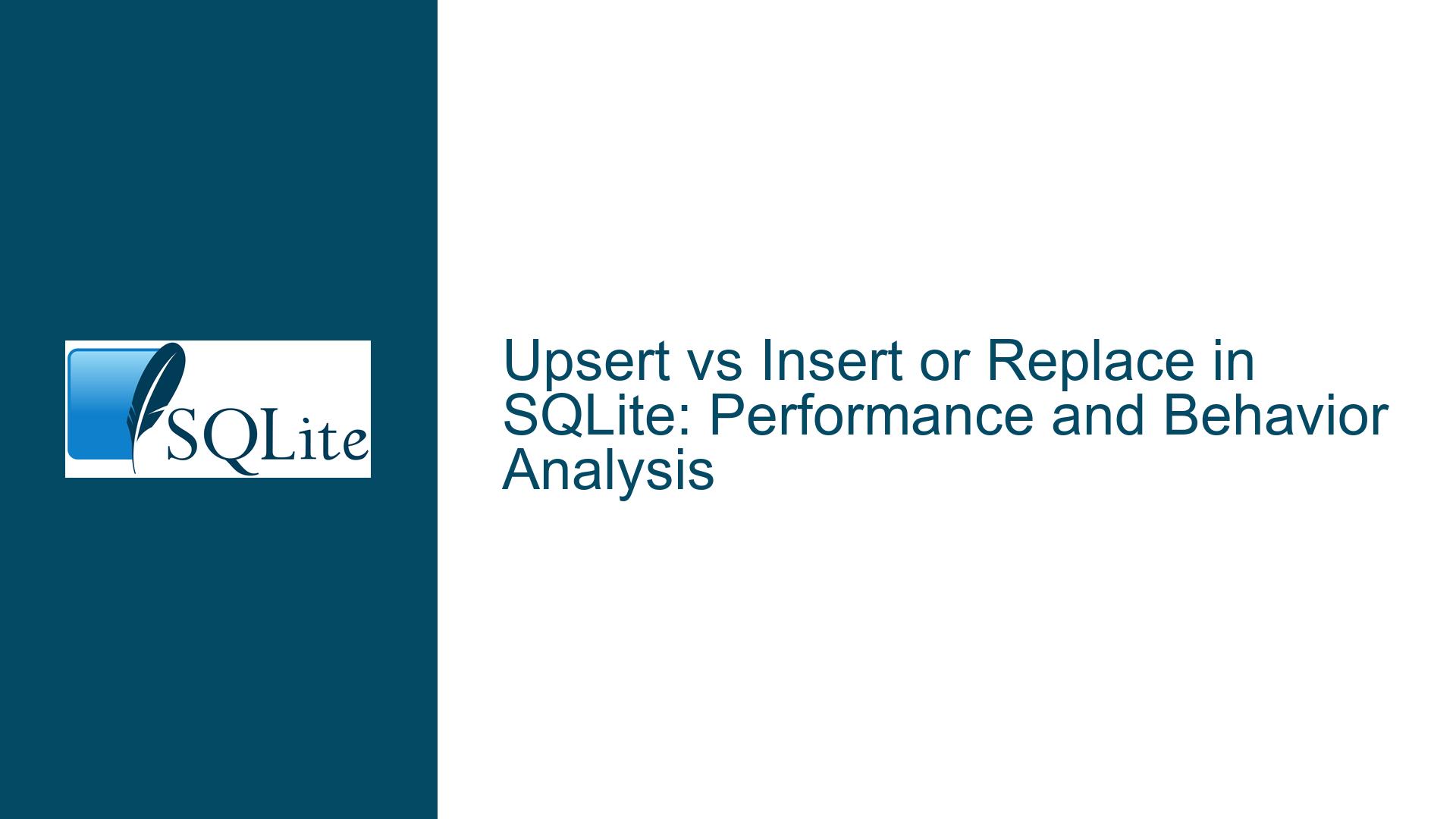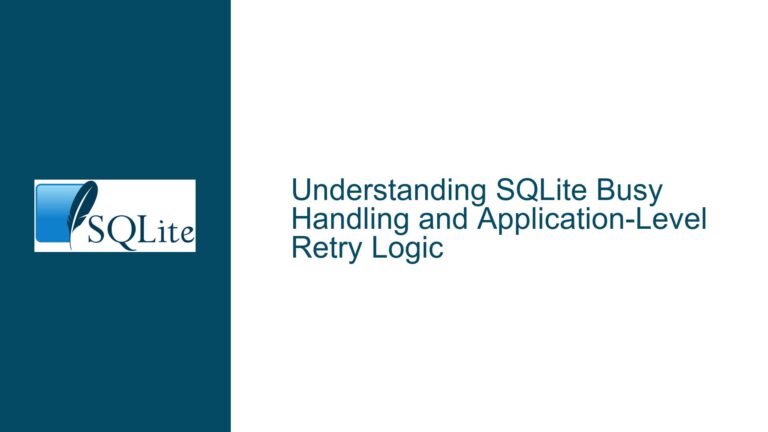Upsert vs Insert or Replace in SQLite: Performance and Behavior Analysis
Understanding the Differences Between Upsert and Insert or Replace
The core issue revolves around the choice between using INSERT OR REPLACE and INSERT ... ON CONFLICT DO UPDATE in SQLite, particularly when dealing with tables defined with the WITHOUT ROWID clause. Both approaches are used to handle situations where a record might already exist, but they differ significantly in their underlying mechanics and implications for performance, data integrity, and behavior with triggers and foreign keys.
The INSERT OR REPLACE statement is a shorthand that performs either an insert or a delete followed by an insert. When a conflict occurs (e.g., a primary key or unique constraint violation), SQLite first deletes the existing row and then inserts the new row. This behavior can have unintended consequences, especially when foreign key constraints with ON DELETE CASCADE are involved, as it triggers cascading deletes. Additionally, triggers defined on the table will fire for both the delete and insert operations, which may not be desirable in all scenarios.
On the other hand, INSERT ... ON CONFLICT DO UPDATE is a true upsert operation. It attempts to insert a new row, but if a conflict arises, it updates the existing row instead of deleting it. This approach preserves the original row and only modifies the specified columns, avoiding the overhead and side effects of a delete operation. This makes it more suitable for scenarios where maintaining referential integrity and minimizing trigger activity are important.
The choice between these two methods depends on the specific requirements of the application, including the need for performance optimization, the presence of foreign key constraints, and the behavior of triggers. Understanding these differences is crucial for making informed decisions when designing and implementing database operations.
Impact of WITHOUT ROWID on Upsert and Insert or Replace
The WITHOUT ROWID clause in SQLite changes the way tables store and manage data. In a standard table, each row has an implicit rowid column that serves as a unique identifier. However, in a WITHOUT ROWID table, the primary key itself is used as the row identifier, eliminating the need for a separate rowid column. This can lead to more efficient storage and faster lookups, especially for tables with a composite primary key.
When using INSERT OR REPLACE or INSERT ... ON CONFLICT DO UPDATE on a WITHOUT ROWID table, the absence of a rowid does not fundamentally change the behavior of these statements. However, it does affect how conflicts are detected and resolved. Since the primary key is used as the row identifier, conflicts are determined based on the primary key values. This means that the choice between INSERT OR REPLACE and INSERT ... ON CONFLICT DO UPDATE should be guided by the same considerations as for tables with a rowid, such as the need to avoid cascading deletes and unnecessary trigger activity.
One important consideration for WITHOUT ROWID tables is the performance impact of these operations. Because the primary key is used as the row identifier, lookups and updates can be more efficient, especially for large tables with a well-defined primary key. However, the performance benefits of WITHOUT ROWID tables can be offset by the overhead of INSERT OR REPLACE if it results in frequent delete and insert operations. In contrast, INSERT ... ON CONFLICT DO UPDATE can be more efficient in such cases, as it avoids the overhead of deleting and reinserting rows.
Performance Considerations and Optimization Strategies
When dealing with large datasets, such as inserting thousands of files into a table, performance becomes a critical factor. The choice between INSERT OR REPLACE and INSERT ... ON CONFLICT DO UPDATE can have a significant impact on the overall performance of the operation. In the case of inserting files into a filetable with columns Path, Name, and thedata, the majority of the files may not change between insertions. This raises the question of whether it is worth comparing the source file to the existing blob data to skip unnecessary writes.
SQLite is highly optimized for performance, and even operations that involve thousands of files can be completed in less than a second when executed within a transaction. However, this does not mean that SQLite skips writes when the data has not changed. In fact, SQLite will still perform the write operation, even if the new data is identical to the existing data. This is because SQLite does not automatically compare the new data with the existing data before performing the write. As a result, unnecessary writes can occur, which may impact performance, especially for large datasets.
To optimize performance, one strategy is to manually compare the source file with the existing blob data before performing the insert or update operation. This can be done by querying the table to retrieve the existing blob data and comparing it with the new data. If the data is identical, the insert or update operation can be skipped, reducing the number of write operations and improving overall performance. However, this approach adds complexity to the code and may introduce additional overhead, especially if the comparison is performed for every file.
Another optimization strategy is to use INSERT ... ON CONFLICT DO UPDATE instead of INSERT OR REPLACE. As mentioned earlier, INSERT ... ON CONFLICT DO UPDATE performs an update instead of a delete and insert, which can be more efficient, especially for large datasets. Additionally, this approach avoids the overhead of cascading deletes and unnecessary trigger activity, further improving performance.
In conclusion, the choice between INSERT OR REPLACE and INSERT ... ON CONFLICT DO UPDATE in SQLite depends on the specific requirements of the application, including the need for performance optimization, the presence of foreign key constraints, and the behavior of triggers. Understanding the differences between these two approaches and their implications for WITHOUT ROWID tables is crucial for making informed decisions and optimizing database operations. By carefully considering these factors and implementing appropriate optimization strategies, it is possible to achieve efficient and reliable database performance, even when dealing with large datasets.






